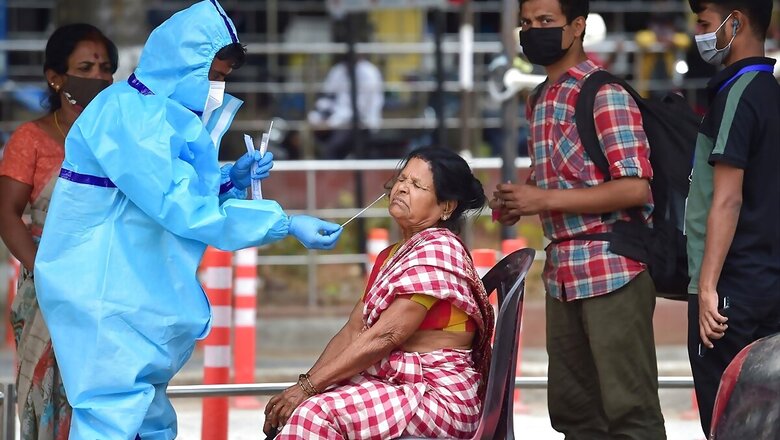
views
February 13, 2021. With my morning cup of coffee, I browse the metrics tab of our app (covind19.org) that our research team has built for studying the COVID-19 pandemic in India. I see the effective reproduction number ‘R’ creeping back up again, to cross the unity line. It had stayed below one for a while now.
For the last one year, I have obsessively tracked these numbers. The virus curve turned the corner in September and steadily declined over the next five months till mid-February. This slight increase could just be random variation, my statistician friends tell me. But I have an ominous feeling. The sniff test for a statistician or a data hound is the uniformly most powerful test. I tweet about this uptick on February 18, I urge that we accelerate the vaccination drive while the case-counts are low. We should not rely on ephemeral herd immunity from natural infections but push for stronger vaccination induced immunity. My tweet does not gain much traction.
We were all tempted with a premature celebration of the end of the pandemic in India, throwing caution to the wind. Scientists including myself were busy coming up with several hypotheses regarding why the virus curve turned its corner, the miraculous decline in India, deciphering a major public health mystery. Citizens who had adopted stringent public health measures for months were finally coming out of their cocoons to resume normal life. Elaborate weddings were happening again with full grandeur.
Seroprevalence studies in many metros had indicated that in most major urban metros roughly one out of two people had a past infection and carried antibodies and thus had some level of immunity. Many argued that because of this large number of covert or silent infections, the transmission slowed down in populous metros. However, India is nearly 70 per cent rural, and the last national serosurvey showed approximately 21 per cent prevalence of antibodies in January 2021. As a country, India was still far away from the “herd immunity” threshold, again justifying the need for rapid escalation of vaccines when the virus incidence curve was in its valley.
What Explains Surge since February
What changed in February? It is probably a confluence of many factors that have been at play including waning immunity from past infections, lack of COVID-appropriate behaviour, that too right when the country was fully reopening. Upcoming elections led to massive rallies. The public metros, trains were all operating at full capacity. Theatres, malls, restaurants with indoor dining were all opening, kids went back to school. Religious gatherings resumed. Use of masks and social distancing were highly recommended, but most of us forgot that guideline with a false sense of security that the virus has magically disappeared.
The virus also had access to “fresh prey” with people like my own family engaging in more risky activities compared to the past year. We had renewed confidence in the future as (thanks to spectacular science) there were two vaccines that were approved in India and were being rolled out, our hope in a vial! Even with that exciting news, the complacency in the air encouraged people to plan vacations instead of vaccinations, leading to a sluggish start to COVID-19 immunization in India.
However, none of these processes including human behaviour, re-infection, waning immunity (latest studies show 84 per cent protection at seven months from past infections) can explain the spike and growth that we saw in March and April in India. Emergence of new variants of concern that are potentially more transmissible and can evade neutralizing antibodies produced by past infections or even a vaccine is most likely responsible for the astronomic surge. We now know about the existence of multiple such variants including the UK variant (B.1.1.7) and the Indian double mutant (B.1.617), which I believe have spread widely across the country.
10-point Guide to Beat Dire Projection
We could dissect all the reasons and failures that led to this catastrophe, but we will not be able to change the past and simulate a counterfactual alternate reality. What we can do is change the course of this pandemic right now through policies guided by science, data and humanity. If we let this virus run wildly, there will soon be no other option except a prolonged national lockdown with crushing economic and social consequences. The epidemiological models are predicting 5 lakh cases, 25,000 hospitalizations and 3,000 deaths every day in four weeks if things continue as they are. So, here are my 10 summary takeaways as we look into the future that can help us beat the dire model projections and look forward to a COVID-adaptive future.
1. Genomic sequencing has to be integrated with routine epidemiologic surveillance. Every case of re-infection and breakthrough infection post-vaccination has to be at a high priority for sequencing. The goal is not just to identify known variants but to discover emerging variants in real time.
2. There is a need for tremendous scaling up of vaccinations. We need to vaccinate approximately 800 million adults with two doses. Ten million doses a day will take us five to six months to vaccinate the adults. Right now, only about 1 per cent of the population is fully vaccinated in India. The decision to provide Emergency Use Authorization (EUA) to all internationally approved vaccines is a welcome step. Pressing pedal to the floor, India can manufacture vaccines at wartime speed. We can incentivize vaccination, take mobile immunization camps to every neighbourhood and community. One-dose vaccines may alleviate issues with adherence. We need to seek help from international partners to secure more vaccines.
3. Intensify containment measures and messaging. Restrict interstate mobility and ban large gatherings. Issue a national mask mandate in public places/transportation. If we adhere to these measures religiously, we can avoid prolonged national lockdowns.
4. Scale up testing and COVID-care capacity. The surge is surely going to overwhelm the hospitals. Public-private partnership is key here. Regional lockdowns may be necessary when the system is collapsing.
5. We need strong data to understand the interplay of vaccines and variants. Post-marketing surveillance studies for safety and real-world effectiveness of multiple vaccines need to be carefully set up for a decentralized health system like India.
6. Indoor dining without following social distancing and restricted capacity guidelines should be immediately prohibited. Bars, coffee shops, gyms have been identified as areas of high transmission and occupancy should be drastically reduced.
7. We need data on who are experiencing severe COVID symptoms. Individual-level data, beyond the bare minimum, has been hard to obtain; India needs a richer health data infrastructure moving forward.
8. Impose strict quarantine for international travellers and sequence any diagnosed cases in this group.
9. Provide a social safety net to the poor, to the vulnerable, to the daily wage earners; they need incentives to comply with public health guidelines.
10. The concept of herd immunity is elusive. Even with high levels of vaccination, we have to have a data adaptive agile public health system, prepared to track down every case and its contacts. The virus and variants are going to remain a part of our lives for the foreseeable future. Let us not live in denial. You cannot wait to see the deaths and cases surge, the lagged effect of the virus makes it treacherous to control. We need proactive prevention not reactive measures. Investing in vaccination, sequencing, public health surveillance system, health data and information platforms will require massive investments but the cost is miniscule compared to the astronomic economic, humanitarian and social cost that the country will suffer in the absence of them.
Finally, a plea to the global community. If saving lives worldwide is our goal, Brazil and India need international partners and allies to get more vaccines and COVID-care supplies. The value of every human life should be equal across the world. Particularly with so many safe, affordable and effective vaccines within reach in a few months, it is unfortunate to lose countless lives. No one in the world is safe until everyone in the world is safe. Our health is interconnected.
Read all the Latest News, Breaking News and Coronavirus News here. Follow us on Facebook, Twitter and Telegram.


















Comments
0 comment